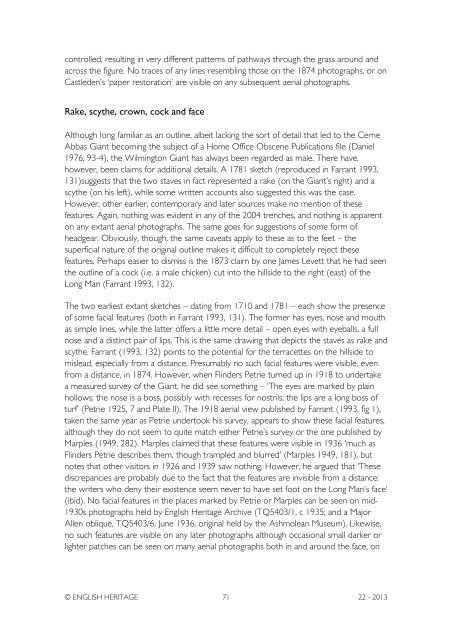Aerial Investigation and Mapping Report - English Heritage
Aerial Investigation and Mapping Report - English Heritage
Aerial Investigation and Mapping Report - English Heritage
You also want an ePaper? Increase the reach of your titles
YUMPU automatically turns print PDFs into web optimized ePapers that Google loves.
controlled, resulting in very different patterns of pathways through the grass around <strong>and</strong>across the figure. No traces of any lines resembling those on the 1874 photographs, or onCastleden’s ‘paper restoration’ are visible on any subsequent aerial photographs.Rake, scythe, crown, cock <strong>and</strong> faceAlthough long familiar as an outline, albeit lacking the sort of detail that led to the CerneAbbas Giant becoming the subject of a Home Office Obscene Publications file (Daniel1976, 93-4), the Wilmington Giant has always been regarded as male. There have,however, been claims for additional details. A 1781 sketch (reproduced in Farrant 1993,131)suggests that the two staves in fact represented a rake (on the Giant’s right) <strong>and</strong> ascythe (on his left), while some written accounts also suggested this was the case.However, other earlier, contemporary <strong>and</strong> later sources make no mention of thesefeatures. Again, nothing was evident in any of the 2004 trenches, <strong>and</strong> nothing is apparenton any extant aerial photographs. The same goes for suggestions of some form ofheadgear. Obviously, though, the same caveats apply to these as to the feet – thesuperficial nature of the original outline makes it difficult to completely reject thesefeatures. Perhaps easier to dismiss is the 1873 claim by one James Levett that he had seenthe outline of a cock (i.e. a male chicken) cut into the hillside to the right (east) of theLong Man (Farrant 1993, 132).The two earliest extant sketches – dating from 1710 <strong>and</strong> 1781 – each show the presenceof some facial features (both in Farrant 1993, 131). The former has eyes, nose <strong>and</strong> mouthas simple lines, while the latter offers a little more detail – open eyes with eyeballs, a fullnose <strong>and</strong> a distinct pair of lips. This is the same drawing that depicts the staves as rake <strong>and</strong>scythe. Farrant (1993, 132) points to the potential for the terracettes on the hillside tomislead, especially from a distance. Presumably no such facial features were visible, evenfrom a distance, in 1874. However, when Flinders Petrie turned up in 1918 to undertakea measured survey of the Giant, he did see something – ‘The eyes are marked by plainhollows; the nose is a boss, possibly with recesses for nostrils; the lips are a long boss ofturf’ (Petrie 1925, 7 <strong>and</strong> Plate II). The 1918 aerial view published by Farrant (1993, fig 1),taken the same year as Petrie undertook his survey, appears to show these facial features,although they do not seem to quite match either Petrie’s survey or the one published byMarples (1949, 282). Marples claimed that these features were visible in 1936 ‘much asFlinders Petrie describes them, though trampled <strong>and</strong> blurred’ (Marples 1949, 181), butnotes that other visitors in 1926 <strong>and</strong> 1939 saw nothing. However, he argued that ‘Thesediscrepancies are probably due to the fact that the features are invisible from a distance:the writers who deny their existence seem never to have set foot on the Long Man’s face’(ibid). No facial features in the places marked by Petrie or Marples can be seen on mid-1930s photographs held by <strong>English</strong> <strong>Heritage</strong> Archive (TQ5403/1, c 1935; <strong>and</strong> a MajorAllen oblique, TQ5403/6, June 1936, original held by the Ashmolean Museum). Likewise,no such features are visible on any later photographs although occasional small darker orlighter patches can be seen on many aerial photographs both in <strong>and</strong> around the face, on© ENGLISH HERITAGE 71 22 - 2013

















